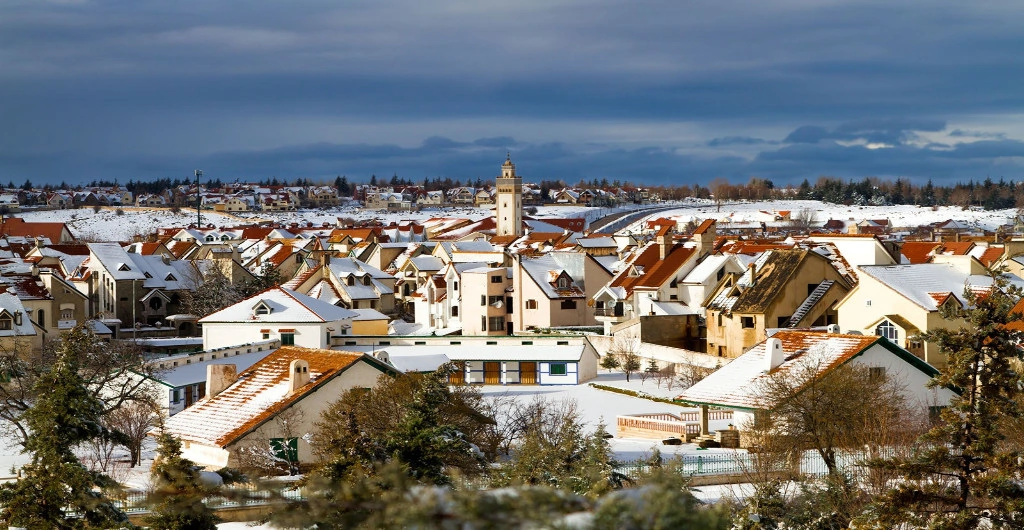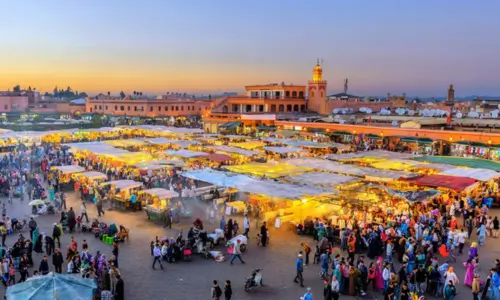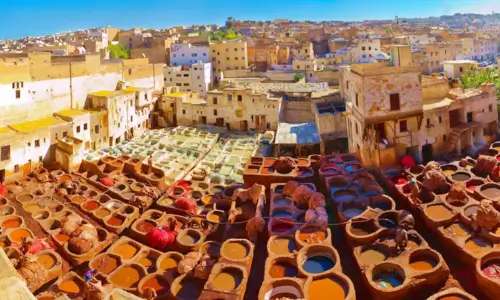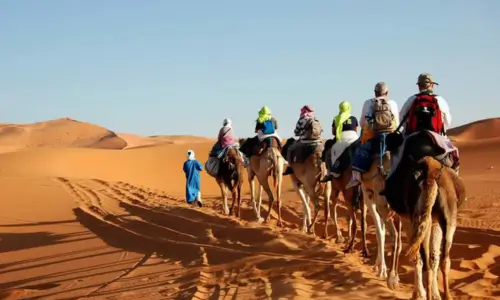Guide to Ifrane, Morocco
Ifrane (Amazigh: ⵉⴼⵔⴰⵏ, Ifran; Arabic: إفران) is a city and urban commune in Morocco located in the Middle Atlas Mountains, at an altitude of 1,713 meters. It is the capital of the province of Ifrane, in the administrative region of Fez-Meknes, and has a population of 30,000 inhabitants.

Ifrane is called “Little Switzerland” for its climate and landscape, as well as for its cleanliness – it is the second cleanest city in the world in 2020.
Content. Ifrane Morocco
1 Toponymy and etymology
2 History of Ifrane
2.1 Prehistory
2.2 Contemporary times
3 Geography
3.1 Location
3.1.1 Climate
3.2 Biodiversity
3.3 Ifrane National Park
4 Tourist sites
Toponymy and etymology
In Amazigh, ⵉⴼⵔⴰⵏ ifran means hiding places or caves (plural of ⵉⴼⵔⵉ ifri). Indeed, the region is known for its natural caves dug into the Jurassic carbonate layer in the form of karsts, extending to the regions of El Hajeb and Sefrou. They are the ones that gave the city its name. Out of ignorance, the name Oufrane has been associated with the name Ifrane, whereas the latter refers to a city located in the Moroccan Anti-Atlas. Historically, the ancient name of Ifrane is Tourtite Turtit, which in Amazigh means garden [1] [archive]. The development of Ifrane and its region is largely due to the natural potential, especially the cedar.
History of Ifrane, Morocco
Prehistory
Human presence in the region dates back to the Neolithic, as attested by caves such as those of Tizguite, as well as archaeological remains dating back to Prehistoric times, 50. 000 years ago, the discovery of Aterian camps (Paleolithic culture characteristic of the Maghreb) by the group of researchers from the Institute of Archaeology and Heritage Sciences (INSAP) in Michlifen, near Azrou, in Ain Leuh (cave ifri Ouberid), Zerouka, Ghabt, Al Bahr and Itto and El Hajeb and the remains found (bones, objects …).
Contemporary period
Ifrane will be inhabited later by a population coming from the two great Amazigh tribes of Tamazight language of Morocco, the Aït M’guild and the Aït M’tir and part of the Aït Seghrouchen, nomadic tribes moving between the green pastures of Timahdite and Azrou to the borders of the country of the Zayans.
Given its geographical situation in altitude oriented towards the north which makes its landscapes comparable to those of Europe, the creation of Ifrane is the work of the Secretary General of the Protectorate in Morocco, Eirik Labonne, in 1928. Three dates should be remembered:
Creation of a summer camp for French settlers: Order of the vizier of September 16, 1929.
Creation of the municipality: January 14, 1947.
Creation of the province.
The choice of the colonial power is inscribed in three frameworks:
Exploitation of natural resources;
Creation of a “European city” to compensate for the disorientation of the French and European community established in Morocco, especially in summer (coolness): Maurice de Gandillac is a witness of it1 ;
To have a strategic base: The garrison of Timahdite constituted a strategic military asset that served as a link between Taza and Tadla to facilitate military interventions and to identify the Amazigh tribes hostile to the colonial presence, especially the tribe of the Zayans under the leadership of Mouha or Hammou Zayani, Mouha or Said of Elkssiba and other insurgent nuclei of the Middle and High Atlas known for their hostility towards the Iroumin (Christians) and their warrior quality fueled by their attachment to the land, especially after the defeat of France on November 13, 1914 at Khénifra in the battle of Elhri.
Al Akhawayn University of Ifrane was founded by royal decree in 1993 and officially inaugurated by King Hassan II of Morocco on January 16, 1995. It is currently the only Moroccan university that follows an American educational system and has more than 40% international staff.
Geography
Location
Ifrane, a city in the central Middle Atlas, is characterized by its European urbanism. It is the capital of the province of Ifrane, which covers an area of 3 573 km² and is administratively composed of two municipalities (Ifrane and Azrou), five caïdats (Tizguite, Dait Aoua, Ain Leuh, Timahdit and Irklaouen) and eight rural communes (Tizguite, Dait Aoua, Ain Leuh, Sidi El Mekhfi or Sidi Addi, Timahdite, Ben Smim, Oued Ifrane and Tigrigra. According to the new administrative division, the province is part of the Fez-Meknes region.
Climate in Ifrane
Ifrane has a very humid and temperate climate, with an annual rainfall of 1,118.4 mm and an average annual temperature of 11.4 °C (52.4 °F).
The northern slope of the Middle Atlas is the most irrigated region of Morocco after the Rif mountain range. Rainfall occurs mainly in winter. The Middle Atlas is then in the path of disturbances coming from the Atlantic.
At an altitude of 1,665 meters, the summer in Ifrane is short but pleasantly warm2, dry and sunny. The average maximum temperature rises from 22°C in June to over 28°C in July and August, before dropping rapidly back below 25°C in September.
In winter it snows a lot in the city. Ifrane officially holds the record for the coldest day on the African continent, with a temperature of -23.9°C on February 11, 1935.3
Biodiversity
The Ifrane region is a geographic area rich in faunal and floristic biodiversity, but its S.I.B. (Sites of Biological and Ecological Interest) and its national park are under heavy pressure due to forest degradation, overgrazing and unwary visitors described as potential polluters.
Ifrane National Park
Ifrane National Park is home to the largest cedar forest in the world. It includes a set of biodiversity sites (Tizguite Park, Val d’Ifrane, Vittel springs, Dait Aoua, Dait Hachlaf, Dait Ifrah and Afourgah).
Tourist sites.
What to see in Ifrane Morocco
Its construction by the French, begun in 1929 as a seaside resort, was inspired by Alpine architecture.
It has a large Royal Palace, the University of Al Akhawayn, a military academy and many luxury villas that dot the city with trees and manicured walks. It is an entertainment city for summer and winter sports.
In the center is a lake surrounded by forests, next to which it is possible to contemplate the Lion of Ifrane, a stone sculpture that tourists like to photograph. As a reminder of the protectorate, there are still some original houses, the post office and the church.
The colonial-era Ville Jardin neighborhood (called Riad) has summer houses and resorts.
Popular neighborhoods are to the north.
The Tourtite International Festival is noted for its cultural activities, with a variety of music, art, nature and sports. The Cedar Song Festival is held in summer. The Miss Snow Festival coincides with the winter, with many activities.
Ifrane is a good place to stay overnight or serve as a stage of the desert circuit thanks to its good geographical location, although the hotel offer is limited. However, the luxurious and expensive Michlifen Ifrane Suites & Spa, the modest but centrally located Grand Hotel Ifrane, the Hotel Chamonix and the decent Farah Inn and Residences de Ifrane are worth mentioning.
In summer, many domestic tourists come from the neighboring cities of Meknes and Fez. It is also home to the prestigious International Summer University. Throughout the year, it is possible to practice horseback riding at the Royal Club.
THE SURROUNDINGS OF IFRANE
Ifrane National Park
An impressive cedar forest, a natural monument and the largest in Morocco. It covers the entire area around Ifrane and Azrou, at an altitude of between 1 500 and 2 000 meters. Its forest of more than 50,000 hectares, the largest reserve of cedars in Morocco and the world, is considered a World Heritage Site by UNESCO. Incredible cedars over 100 years old, grandiose walnut trees and imposing oaks obscure the road and give it a mysterious air. Visit the lakes of Dayet Asaua, Dayet Ifrah, the Valley of Rocks, the Virgin Falls and the summit of Jbel Hebri, next to the winter resort of Michlifen.
Wildlife abounds: monkeys, wild boars, hares and partridges. Trout fishing.
Route of the lakes
There is a circuit of lakes, taking the road from Fez, turning off after 16 km to Dayet Aoua, an ideal place for lunch and bird watching. Continuing along the local road between pines and oaks to Dayet Ifrah, you can admire a beautiful landscape little frequented. On the way back to Ifrane, passing by road 707, you can admire the Valley of Rocks composed of large rock formations.
Michliffen
Ski resort at 2,036 meters above sea level, 17 km away. It can be reached by road 707, after passing the Tizzi n Treten pass at 1,934 meters. This area is a plain dotted with forests and rocks that form strange shapes. The station offers several services and there is a village of the Ifrane Ski Club.
Nearby is the Jebel Hebri resort, at an altitude of 2,014 meters and 22 km away. It does not offer any particular service. It is accessible from Azrou by the road to Midelt.
Before reaching Michlifen, taking a local road that goes east and crosses a high plateau where sheep graze, you reach Boulemane, 55 km away.
Zaouia of Ifrane
Located 5 km along a local road along the Tizguit River.
It is the first settlement in the region, with remains of the primitive Hebrew tribes and a shrine to its founder, the revered Sidi Abdesselam. It is interesting to see the troglodyte houses.
Beni Smim
At 8 km in the direction of Azrou, we find this rural commune, with the Tamanoucht hotel. The women of this region manufacture natural essence of chamomile.
Its water is highly appreciated and is bottled under the name of Eau de Benismim.
During the protectorate, the anti-tuberculosis sanatorium of Bensmim was built on this site, surrounded by forests. It is now abandoned.
Azrou
A 17 km, N-8 southbound, is a mountain town of about 50,000 inhabitants. It is located at an important crossroads linking the region with the desert, on the road to Midelt, Er Rachidia, Erfoud, Merzouga and Marrakech 400 km on the road to Khenifra, Beni Mellal and near the imperial cities of Fez, Meknes 80 km.
City with a moderate hotel offer, with all the modest Panorama Hotel and in the forest, the modern hotel Le Palais des Cerisiers.
Book a hotel near Azrou
Azrou can serve as a base to visit the Middle Atlas Mountains and the desert, or take a trip to Meknes and Fez, which are not far away.
Immouzer Kandar
At 26 km in the direction of Fez is this small summer resort and village in the Atlas Mountains located at an altitude of 1,400 meters. It is a place of great natural beauty and cool climate, of national fame, with a lively main street and a central lake.
DISCOVER OUR TOURS TO SAHARA DESERT IN MOROCCO

FROM MARRAKECH
Our most popular Morocco Sahara Tours . The trip from Marrakech is rich in scenery and includes an unforgettable stay in a Desert Camp.

FROM FES
A great experience starting from Fes including camel trekking and at least one night in a tented desert camp in the Merzouga Desert.

CUSTOM TOURS
Our experts can create exceptional tailor-made experiences for our clients. Contact us and we´ll plan your perfect trip in Morocco.

